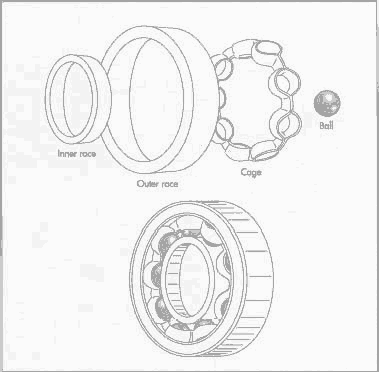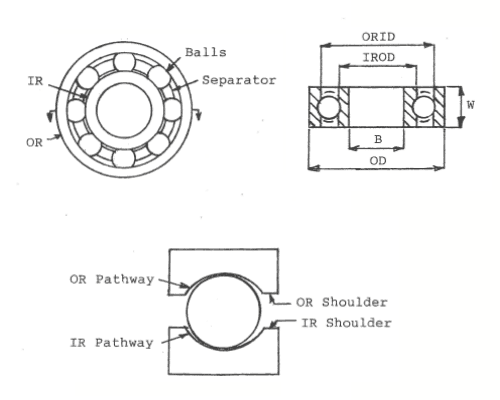Ball bearings are used primarily to support rotating shafts in mechanical equipment. They can be found in everything from personal computers to passenger cars. They are of simple design and can be precision made in mass production quantities. They can support heavy loads over a wide speed range and do it virtually friction free. They come in many different sizes and shapes, are relatively inexpensive, and require little or no maintenance. They have predictable design lives and operating characteristics and are truly a valuable asset to the rotating equipment industry of today.
Ball bearing parts

A ball bearing consists of an inner ring (IR), an outer ring (OR), a complement of balls, and a separator to contain the balls. The outer diameter of the inner ring (IROD) and the inner diameter of the outer ring (ORID) have a groove in which the balls roll on. This groove is commonly called the pathway. The raised surfaces on each side of the pathway are called the shoulders. The balls are held equally spaced around the annulus of the bearing by the separator. The basic dimensions of the bearing are the bore (B), outside diameter (OD), and the width (W).

Ball bearing design
For most bearings, the radius of curvature across the pathway of an inner ring is held to 51-52% of the ball diameter while the radius of curvature across the pathway of the outer ring is held to 53-54% of the ball diameter. As the pathway radius of curvature approaches 50% of the ball diameter (100% of the radius), the stress between the ball and pathway decreases; however, it also moves the contact of the ball higher up the pathway wall producing more friction as the balls revolve around the bearing. For ball bearings, the best balance between stress and friction is attained with the pathway curvature slightly above 50% as described above for inner and outer rings. The number is higher for outer rings because, in the rotational plain, outer rings present a concave surface to the balls lowering the contact stress compared to the inner rings which, in the rotational plane, present a convex surface to the balls raising the stress.
As previously described, the raised surface on each side of the pathway is called the shoulder. The radial difference between the deepest part of the pathway to the OD of the inner ring and to the ID of the outer ring is called the shoulder height. In most bearings it is held to 22-30% of the ball diameter for inner rings and 18-22% for outer rings, with the difference being due to the same reason that the pathway curvatures are not the same for inner and outer rings. The design height of the shoulder is a balance between being high enough to support proportionately high thrust (side) loads and low enough to be able to assemble an adequately sized separator into the bearing. Another design consideration is the minimum wall thickness at the bottom of the pathway of both the inner and outer rings. This section must be thick enough to simultaneously support compressive stresses from the balls on the inside and hoop stresses from press fit assembly on the outside.
Types of ball bearings
The three most commonly used types of ball bearings are deep groove ball bearings, angular contact ball bearings, double row self aligning ball bearings, thrust ball bearings. The radial ball bearing is designed to accommodate primarily radial loads but the deep groove type will support bidirectional thrust loads up to 35% of the radial load before bearing life becomes progressively shorter. The assembled radial bearing is inseparable and may be equipped with seals, shields, and/or snap rings.
Angular contact ball bearings are single row bearings designed so that the line of contact between the balls and inner and outer ring pathways is at an angle to a line 90o to the bearing axis of rotation. The angle between the two lines is called the contact angle. In angular contact ball bearing design, one of the pathway shoulders is removed to allow assembly of a maximum complement of balls for increased load carrying capacity. Angular contact ball bearings support both radial and high one-direction thrust loads.
Double row angular contact ball bearings mounted back-to-back. This type of mounting has good axial and radial rigidity and provides resistance to overturning moments and angular deflection of the shaft. The type of double row angular contact ball bearings mounted face-to-face has the same axial and radial rigidity as back-to-back mounting but less resistance to overturning moments and more compliance to misalignment or bending of the shaft. The type of double row angular contact ball bearings that mounted in tandem provides resistance to high one-direction thrust loading.
Double row ball bearings support heavy radial loads, thrust loads from either direction, or combined radial and thrust loads. They are normally used in positions where radial loads exceed the capacity of a single row bearing with a comparable bore and OD. Double row bearings are designed with the bore and outside diameter the same as single row bearings but are narrower than two single row bearings.

